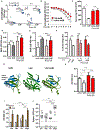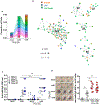Non-protective immune imprint underlies failure of Staphylococcus aureus IsdB vaccine
- PMID: 35803276
- PMCID: PMC9378590
- DOI: 10.1016/j.chom.2022.06.006
Non-protective immune imprint underlies failure of Staphylococcus aureus IsdB vaccine
Abstract
Humans frequently encounter Staphylococcus aureus (SA) throughout life. Animal studies have yielded SA candidate vaccines, yet all human SA vaccine trials have failed. One notable vaccine "failure" targeted IsdB, critical for host iron acquisition. We explored a fundamental difference between humans and laboratory animals-natural SA exposure. Recapitulating the failed phase III IsdB vaccine trial, mice previously infected with SA do not mount protective antibody responses to vaccination, unlike naive animals. Non-protective antibodies exhibit increased α2,3 sialylation that blunts opsonophagocytosis and preferentially targets a non-protective IsdB domain. IsdB vaccination of SA-infected mice recalls non-neutralizing humoral responses, further reducing vaccine efficacy through direct antibody competition. IsdB vaccine interference was overcome by immunization against the IsdB heme-binding domain. Purified human IsdB-specific antibodies also blunt IsdB passive immunization, and additional SA vaccines are susceptible to SA pre-exposure. Thus, failed anti-SA immunization trials could be explained by non-protective imprint from prior host-SA interaction.
Keywords: IsdB; S. aureus; Staphylococcus aureus; antibody; antibody competition; immunization; original antigenic sin; vaccine; vaccine failure.
Copyright © 2022 The Author(s). Published by Elsevier Inc. All rights reserved.
Conflict of interest statement
Declaration of interests C.-M.T. and G.Y.L. have filed for a patent application for the use of IsdB NEAT2 as a vaccine.
Figures






References
-
- Anderson AS, Scully IL, Timofeyeva Y, Murphy E, McNeil LK, Mininni T, Nunez L, Carriere M, Singer C, Dilts DA, et al. (2012). Staphylococcus aureus manganese transport protein C is a highly conserved cell surface protein that elicits protective immunity against S. aureus and Staphylococcus epidermidis. J Infect Dis 205, 1688–1696. - PMC - PubMed
-
- Bennett MR, Dong J, Bombardi RG, Soto C, Parrington HM, Nargi RS, Schoeder CT, Nagel MB, Schey KL, Meiler J, et al. (2019). Human VH1–69 Gene-Encoded Human Monoclonal Antibodies against Staphylococcus aureus IsdB Use at Least Three Distinct Modes of Binding To Inhibit Bacterial Growth and Pathogenesis. mBio 10. - PMC - PubMed
MeSH terms
Substances
Grants and funding
LinkOut - more resources
Full Text Sources
Other Literature Sources
Medical
Molecular Biology Databases

